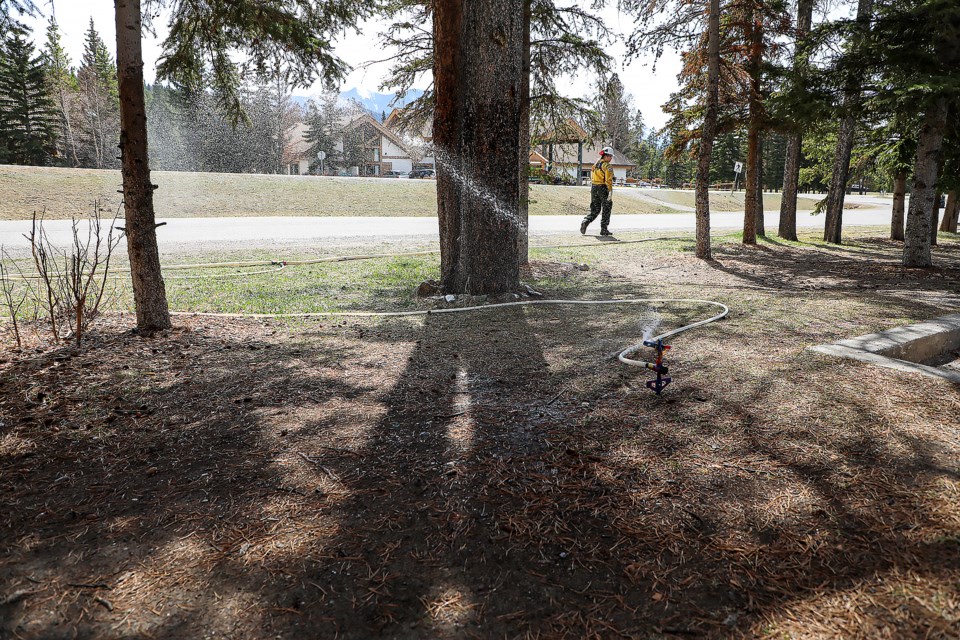BANFF NATIONAL PARK – An influx of an estimated $18 million in federal money will see the national fire equipment cache in Banff National Park be upgraded and a new facility built.
Parks Canada announced Thursday (July 6) the facility will serve as a central equipment storage location that will help with equipment reserve use across the country.
The new build will replace the existing facility in the industrial compound of Banff that was constructed in the 1990s and the aim is to have it operational in the next 18 to 22 months.
“For Parks Canada, it’s huge. … The existing cache was a facility we started using in the 1990s and everything’s evolved,” said Jarred Picher, director of national resource management branch for Parks Canada.
“One of the key things with wildfire in Canada is up until very recently we’ve been suppression, suppression, suppression as opposed to prevention and mitigation and using things like FireSmart to reduce the overall risk to use things like prescribed fire as a way to reduce fuel loads and really sort of anticipate what would happen if major wildfire situations occur.”
Picher said the facility will house tools to respond to and mitigate wildfires such as roof-mounted and perimeter sprinkler systems, thousands of feet of hose, chainsaws, axes and other needed equipment for wildfire response.
He noted Banff offers a strategic location due to its proximity to several national parks and townsites such as Banff, Waterton and Jasper that allows the equipment to be quickly mobilized.
“It’s going to help our team be able to maintain those critical resources in good shape. We’ve already deployed quite a bit of equipment this year, so when we get it back we have to make sure it’s operating properly,” Picher said. “There’s a lot of work that goes into maintaining the cache and this facility is really going to give us an opportunity to do an even higher standard for Parks Canada.”
The 2023 wildfire season has been especially destructive in Alberta. As of July 13, there have been 841 wildfires and 1.55 million hectares of forest burned for the most in at least the last 20 years.
In a Thursday (July 6) media conference, federal Emergency Preparedness Minister Bill Blair said 2023 is the worst Canadian wildfire season in recorded history with just under nine million hectares of forest being burned in more than 3,400 wildfires this year.
Though the risk is likely to decrease somewhat in August, western and northern Canada, Ontario and western Quebec will remain at a high risk.
He noted the “risk of fire activity is going to remain very high throughout the majority of the summer.”
A Parks Canada media release stated specialized fire management equipment will “be maintained in a state of readiness where it can be quickly deployed to Parks Canada administered places across Canada or shared with provincial and territorial partners through the Canadian Interagency Forest Fire Centre.”
Since 2021, Parks Canada’s National Fire Management program has received $65 million from the federal government.
According to Parks Canada, the funding has aided in helping with the scope of wildfire risk reduction work, added more fire management specialists and firefighting crews and increased the government’s ability to train the specialized personnel.
“The recent wave of wildfires across Alberta and Canada has severely affected millions of Canadians,” said Randy Boissonnault, the Minister of Tourism and Associate Minister of Finance in a media release.
“We have seen thousands of Albertans leaving their homes to flee the fires, communities destroyed and livelihoods threatened. … Parks Canada’s national fire equipment cache will enhance Parks Canada’s capacity to respond to wildfire incidents and to support other fire management agencies when they need assistance.”
Parks Canada manages a wildland fire area of 350,195 square kilometres of federal Crown land.
In May, a prescribed fire near the Banff townsite got out of control. The compound meadows prescribed burn was brought under control and extinguished, but it burned about three hectares of land on the west side of Banff Avenue.
It forced the evacuation of Banff Rocky Mountain Resort and Mount View Barbecue, and destroyed property at the Banff Light Horse Association corrals and the iconic Bill Peyto entrance sign welcoming people to Banff.
“We need to be able to respond, but we also need to be able to use our program to prevent and mitigate those risks as much as possible. The cache is going to give us that opportunity,” Picher said. “It’s that central location where we’ll be able to mobilize our resources and allow us to make sure we are continuing to have the best equipment, high standard of maintenance and be ready to go. … The preparedness part for Parks Canada is critical, so making sure we have the appropriate tools to be able to do that across the country is fundamental.”
Picher highlighted a key aspect is resource sharing between Parks Canada and provincial and territorial partners through the Canadian Interagency Forest Fire Centre.
“When we’re in need from a wildfire perspective, we all work together. … This year is another example where everybody’s trying their best to protect values at risk, protect communities, work with our partners and stakeholders or Indigenous communities that are around our parks to make sure that we’re doing all that we can to keep Canadians safe,” he said.




